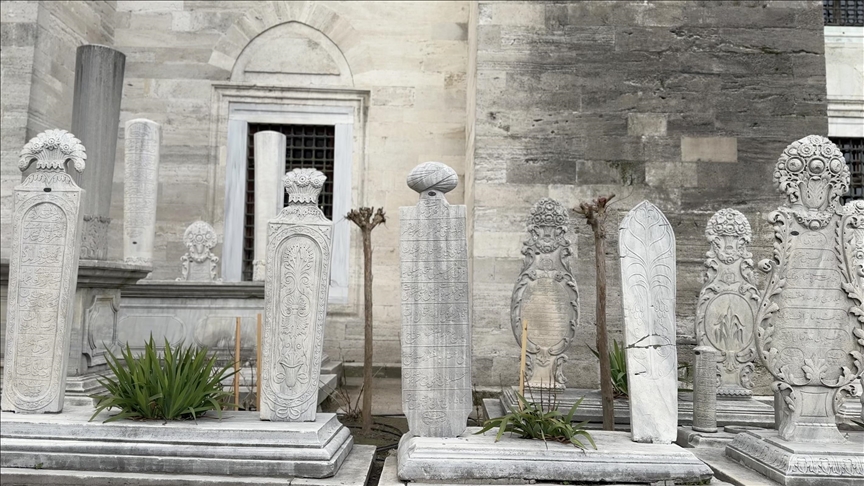Tombs and traditions: How Istanbul's burial grounds weave together Türkiye's largest city
Walking through a Muslim cemetery on your way to public transit or passing Greek Orthodox tombstones after leaving a shopping mall — life and death are 'closely intertwined' in Istanbul, says author Fatih Cavus
 Ottoman-era gravestones in the cemetery located in the courtyard of Suleymaniye Mosque, Istanbul. ( Zeynep Ozturk - Anadolu Agency )
Ottoman-era gravestones in the cemetery located in the courtyard of Suleymaniye Mosque, Istanbul. ( Zeynep Ozturk - Anadolu Agency )
- Monumental, 'cabin-shaped' tombs decorate the city's Greek Orthodox Cemetery, showcasing elaborate craftsmanship that is difficult to come by today, says clergyman Gedeon Varytimos
- At one of Istanbul's Jewish cemeteries, the variety of languages on tombstones are a reflection of diversity, as many members of the community have migrated from distant parts of the world, explains Cemetery Director Natan Siliki
ISTANBUL
While abroad, renowned Turkish poet Yahya Kemal was once asked a seemingly simple question: “What is Türkiye’s population?”
His response was a figure so high that those around him were taken aback.
“Why the surprise? We live with our dead,” he explained.
Kemal, whose grave can be found in the Asiyan Cemetery, renowned for its sweeping views of the Istanbul Strait and as the final resting place of many poets and musicians, offers a glimpse into the customs surrounding the city’s cemeteries.
In Istanbul, the notion of “living alongside the dead” is not just a metaphor, something that becomes strikingly apparent as you navigate the city’s streets.
You might walk through a Muslim cemetery on the way to the metro or bus, or leave a shopping mall to face the towering gravestones of a Greek Orthodox cemetery, with massive crosses at their center.
Istanbul is an ancient city with a population of over 15 million. Today, it is home to a wide array of cemeteries serving Muslims as well as Christian, Jewish, and other communities. Many date back centuries, including those established during Ottoman rule beginning in the mid-15th century.
As the city has expanded and urbanized over the centuries, cemeteries that were once on the outskirts now sit at its very heart.
Life and death intertwined
A cultural element also plays a key role in this, explains Fatih Cavus, an author specializing in Ottoman gravestones.
“Life and death were closely intertwined in the Ottoman era. But cemeteries today are found on the outskirts of the city.
“Back then, burials took place in the courtyards of mosques and tombs, even in schoolyards. People witnessed death,” he tells Anadolu.
Walking through the cemetery in the courtyard of Suleymaniye Mosque — one of the historical peninsula’s landmarks — takes you past the tombs of famed Ottoman Sultan Suleyman the Magnificent and his wife, Hurrem Sultan, also known as Roxelana.
In this small cemetery, where burials require special permission, one of the first things you will notice are gravestones carved into shapes resembling turban-like headgear, which Ottoman men wore to signify social status.
Cavus explains that cemeteries of the time were usually marked by two gravestones: one at the head and another at the feet of the deceased. If floral decorations appear on the headstone, it marks a woman’s grave; if it is a fez or turban, it signifies that of a man; and if the gravestone is smaller, a child.
He also notes that the cemetery is primarily the resting place for prominent figures of the time, including government officials and nobles.
“According to Ottoman gravestone typology, even without knowing Ottoman Turkish, you can often guess who the grave belongs to based on the decorations.”
Another striking feature of Muslim cemeteries is the “water basins” carved into the graves. These collect rainwater, offering a lifeline to birds, cats, and other passing animals in need of a drink.
As a gesture of compassion toward animals, these water basins are made in line with the Islamic belief that good deeds continue to bring rewards to the deceased even after their passing.

A cat drinks water from a basin carved into an Ottoman-era grave. (Zeynep Ozturk - AA )
City’s largest Greek Orthodox cemetery
In Christian cemeteries, graves often include a space for a vase or container for flowers as a symbol of respect, remembrance, and honoring the deceased.
While the practice varies across Christian denominations, it is generally rooted in the desire to keep the memory of the departed alive and show ongoing care.
In the Greek Orthodox Cemetery located in Sisli, which is one of Istanbul’s central districts, one finds many of these floral decorations and monumental tombs that make the site feel almost like an open-air museum.
Located right across from a well-known shopping mall and nestled between the Armenian Catholic and Italian Jewish cemeteries, this site is the largest cemetery for Istanbul’s Greek community.
Like many other minority cemeteries of its time, it was relocated from Taksim to its current site around 1865 due to urban expansion and the overcrowded, unsanitary conditions caused by a plague outbreak in the city.

Sisli Greek Orthodox Cemetery, Istanbul. ( Zeynep Ozturk - AA )
In an interview with Anadolu, Gedeon Varytimos, the clergyman in charge of Istanbul’s Holy Trinity Church of Pera, shares the story behind the cemetery’s most striking monument, crowned by a grand and majestic statue.
“As a work of art, this monumental tomb belongs to George Zarifi, an Ottoman Greek who was a banker in the 19th century. Known for his wealth and philanthropy, he was a member of the Zarifi family, one of Istanbul’s prominent families during that time.”
Varytimos adds that throughout his life, Zarifi maintained strong ties with the Ottoman Dynasty and even advised Sultan Abdulhamid II on matters related to his personal wealth.

The monumental tomb of George Zarifi, Sisli Greek Orthodox Cemetery, Istanbul. ( Zeynep Ozturk - AA )
One of the cemetery’s most remarkable features is the rows of “cabin-shaped graves” that resemble telephone booths.
Varytimos explains that this design symbolizes “small churches” and were commissioned by wealthy families of the era. However, he notes that such elaborate, expensive graves are no longer built due to the loss of skilled artisans.
Tombstones in Ladino language
In Istanbul’s Ulus Ashkenazi Jewish Cemetery, tombstones inscribed in multiple languages stand alongside those in Hebrew.
Cemetery Director Natan Siliki tells Anadolu that these diverse inscriptions reflect centuries of migration, as Jews who settled in Istanbul brought their languages with them.
From French and Russian to German and Ladino — a Judeo-Spanish language spoken by arrivals from Spain during the Ottoman era — each inscription serves as a lasting tribute to the deceased’s heritage.

Gravestones at the Ulus Ashkenazi Jewish Cemetery, Istanbul. ( Zeynep Ozturk - AA )
The tombstone of Avram Leyon, a Turkish Jewish journalist and founder of Salom newspaper, is a prime example, says Siliki.
“Since Avram Leyon wrote extensively in Ladino for Salom newspaper, which he founded, his gravestone bears the inscription: ‘Aki esta repozando el grande jurnalisto,’ meaning, ‘Here lies the great journalist’,” he explains.
Established in 1920, the cemetery initially served Istanbul’s Ashkenazi Jewish community. However, due to increasing demand, an agreement was later made to allow burials for Sephardic Jews as well.
Siliki also highlights a burial practice specific to Istanbul, where it is performed with coffins, unlike other cities where the deceased are laid to rest with shrouds, similar to Muslim customs.
“In our religion, burials in water are strictly forbidden. In the past, at the Haskoy Cemetery, one of Istanbul’s first Jewish cemeteries, because water was seeping up from the ground, the chief rabbi at the time and the board of trustees made a decision to require burials with coffins.”
The cemetery also contains a memorial tomb to honor the victims of the 1986 and 2003 attacks on the Neve Shalom and Bet Israel Synagogues in Istanbul.
Anadolu Agency website contains only a portion of the news stories offered to subscribers in the AA News Broadcasting System (HAS), and in summarized form. Please contact us for subscription options.





